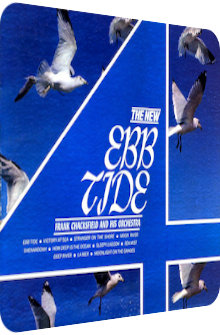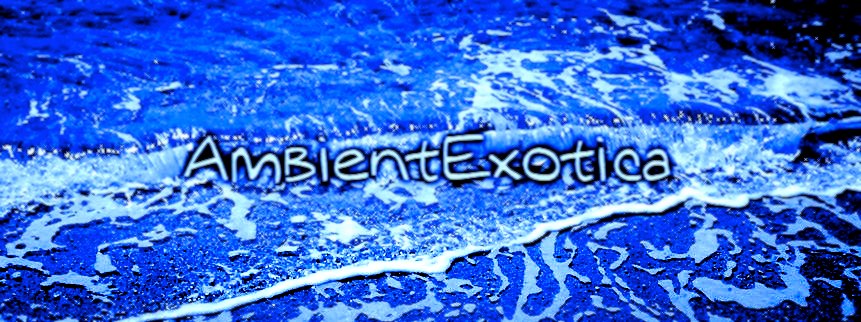
Frank Chacksfield
The New Ebb Tide
1964
The best aquatic concept album in the given context is Les Baxter’s Jewels Of The Sea (1961), an ever-exciting ocean of unique songs, blurry fields of seaweed, technicolor thiazides of coral reefs and that specific dose of mysticism that adds so much to the composer’s craftsmanship. It is unlikely that The New Ebb Tide by composer, arranger and conductor Frank Chacksfield (1914–1995) can offer an experience that is even distantly similar to Baxter’s marine environment, but eureka, this is exactly what that very album accomplishes!
Released on Decca and London Records as part of their Phase 4 Stereo audiophile series, Chacksfield unites 12 classics on this album, all of them aquatic or wet for a number of reasons. The array of songs makes for a success on a thematic level already, but the arrangements are top notch and outshine the curation process by a wide margin. The orchestra is fully equipped: strings, horns, woodwinds, mallet instruments, even field recordings are included and built anew throughout the album. It is only a little unfortunate that no unique song by Chacksfield himself has entered the table of contents, but what the album lacks in unheard songs, it gains in artistic percolations, pluvial suntraps, faraway islands and riverbeds of joy. Those who have given up on the blandness which Chacksfield is (also) known for, let this stellar lighthouse lavabo be your guardian light.
Oh yes, this is a Phase 4 Stereo album alright, noticeable right from the beginning of Carl Sigman’s and Robert Maxwell’s Ebb Tide, kicked off here with a vivid field recording of ocean waves and coastal seagulls which eventually blend with Frank Chacksfield’s vivacious arrangement. Mountainous horns, majestic strings and rumbling timpani become entangled in order to stress the hymnic emanation that this classic can emit when interpreted intriguingly. The mucous harps and sizzling cymbals are on board as well, but the most interesting tweak arrangement-wise is the maintenance of the field recording which never vanishes; one can still hear the cries of the seagulls through the melodious cracks, and once the song simmers down to an annealed state, the breakers still crash against the cliff, with the birds nearby. Maybe this is considered too gimmicky or costly by Chacksfield after all, and so the subsequent material is purely symphonic, ostracizing antimatter ad infinitum.
Irving Berlin’s adjacent How Deep Is The Ocean can live without these additions quite splendidly though. A coruscating-crunchy rhythm guitar serves as the base frame for aeriform strings, longitudinal trumpets and cymbalesque ventiducts. Pompous, cinematic and vivid, Chacksfield’s arrangement is a blast indeed. The traditional Deep River even manages to rev up the swinging nucleus that was presented heretofore. In lieu of a rhythm guitar, jazzy drum kits of the classic kind epitomize the backing beat and serve as the aorta around which many multiplex pizzicato strings, euphonious horn helixes and ebullient flutes are gyring freely. The good nature and memorable setting are a blast, carving out the inherent vivacity whenever possible.
Acker Bilk’s and Robert Mellon’s Stranger On The Shore meanwhile depicts an insouciant legato rivulet of double bass avulsions, glockenspiel droplets and mauve-tinted string infusions of ever-romantic notions – there’s even an elasticized surf guitar on board –, whereas Chester Wallace’s and Sherman Myers’ exotic Moonlight On The Ganges adheres to particularly uplifting spirits, comprising a blend of Bolero-esque motives, glorious show tune sequences, galloping rhythms and translucent strings. A highly delightful addition of a wonderful sparkler! Roger Senicourt’s Sea Mist finishes side A with a benthic-viridian photometry: intendedly blurred woodwinds, stepping drums and liquedous harps are prone to illumine the main placenta of frilly flutes and carefree strings.
Side A, in short, has been a blast. Side B luckily succumbs to the same aesthetics. Launching with the traditional Shenandoah, the aquatic vestibule to romance comprises a lead fiddle and pours it into a duet with a reverberated harmonica that would make Tommy Morgan proud. The focus on these two instruments may not be everyone’s cup of seagrass, but the second section rectifies the situation and amends to this minimalism via bubbly string serenades, downwards-spiraling Space-Age timbres and sinewed horn cataracts.
Charles Trenet’s La Mer continues to travel these wetlands and is ameliorated by another great use of the rhythm guitar. In lieu of a picturesque standstill, the listening subject wanders through fields of glaucous vibraphones, superb string fusillades and caustic brass solutions. The melody remains ever-strong. While Henry Mancini’s and Johnny Mercer’s Moon River is a rustic-romantic affair thanks to nocturnal wind chimes, lead accordions and viscid pizzicato strings, Eric Coates’ and Jack Lawrence’s Sleepy Lagoon turns the spectacle up a notch by featuring a lead coquette surrounded by viscoelastic harps, harbor horns and fittingly drowsy strings. The New Ebb Tide ends with a medley of two Richard Rodgers productions: Song Of The High Seas is a cinematic corker comprising of cello coils, ocean waves, screeching whistles, thundering timpani and scything brass bursts, while Submarines In A Calm Sea absorbs the filmic spirit and washes the listener safely ashore.
The New Ebb Tide is Frank Chacksfield’s greatest record next to Globetrotting, unbelievably vivacious, mercilessly delightful, perfectly aquatic. Here, for once, the sophisticated recording technique of Decca’s Phase 4 Stereo series merges perfectly with a gorgeous halide whose titration process is as reliant on strings and horns as it is on orthochromatic ingredients and substituents, themselves phylogenetic parts that make up the magical allure of this album. From the first note to the last, the listener can sense that the dangerous cliffs of tackiness are skillfully sailed around by coxswain Chacksfield, a curious remark in hindsight, given that the arranger is unfortunately also known for less spirited bog-standard productions. Not so on The New Ebb Tide whose boastful title and comprehensible theme are wondrously translated into music.
There is no particular highlight to cherry-pick, but many tendencies and quirks to cherish: the use of rhythm guitars, the amalgamation of slick surf guitars within symphonic arrangements, the occasional fleeting visit to oceanic field recordings and the polyfoil fusion of polyphony and harmonies altogether make this a delightful album on the brink of Easy Listening, but venturing beyond more often than not. Especially the latter stage comprises of cinematographic protuberances and bursts that even tone down the benignant atmosphere. This sea gem has unfortunately not been remastered or reissued as of yet, but the sound quality of the vinyl speaks for itself and is easily available after all.
Exotica Review 495: Frank Chacksfield – The New Ebb Tide (1964). Originally published on May 29, 2018 at AmbientExotica.com.
